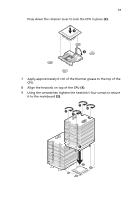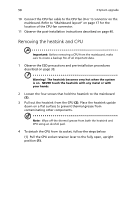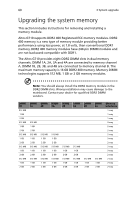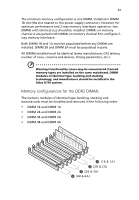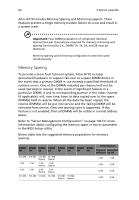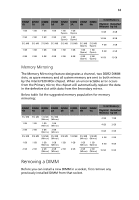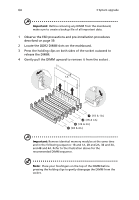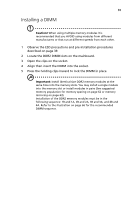Acer Altos G710 Altos G710 User's Guide - Page 72
Memory Sparing, Altos G710 includes Memory Sparing and Mirroring support. These
 |
View all Acer Altos G710 manuals
Add to My Manuals
Save this manual to your list of manuals |
Page 72 highlights
62 3 System upgrade Altos G710 includes Memory Sparing and Mirroring support. These features prevent a single memory module failure to occur and result in a system crash. Important: Four DIMM population of completely identical devices (two per channel) are required for memory mirroring and sparing functionality (i.e., DIMM 1A, 1B, 2A, and 2B must be identical) . Memory sparing and mirroring configuration cannot be used simultaneously. Memory Sparing To provide a more fault tolerant system, Altos G710 includes specialized hardware to support fail-over to a spare DIMM device in the event that a primary DIMM in use exceeds a specified threshold of runtime errors. One of the DIMMs installed per channel will not be used, but kept in reserve. In the event of significant failures in a particular DIMM, it and its corresponding partner in the other channel (if applicable), will, over time, have its data copied over to the spare DIMM(s) held in reserve. When all the data has been copied, the reserve DIMM(s) will be put into service and the failing DIMM will be removed from service. Only one sparing cycle is supported. If this feature is not enabled, then all DIMMs will be visible in normal address space. Refer to "Server Management Configuration" on page 103 for more information about configuring the memory spare or mirror parameter in the BIOS Setup utility. Below table lists the suggested memory population for memory sparing: DIMM 1B DIMM 1A DIMM 2B DIMM 2A DIMM 3B DIMM 3A DIMM 4B DIMM 4A Total Memory Physical Detected Memory by OS 512 MB 512 MB 512 MB 512 MB (Spare) (Spare) 2 GB 1 GB 1 GB 1 GB 1 GB 1 GB (Spare) (Spare) 4 GB 2 GB 2 GB 2 GB 2 GB 2 GB (Spare) (Spare) 8 GB 4 GB 512 MB 512 MB 512 MB 512 MB 512 MB 512 MB (Spare) (Spare) 3 GB 2 GB



